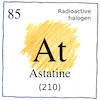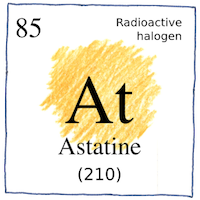Berkeley—Dale R. Corson,
Kenneth Ross MacKenzie,
Emilio Segrè
elements

|
Astatine
Dmitri Mendeleev said that an unknown halogen should come after iodine, eka-iodine. Fred Allison thought he found it and called it alabamine. Rajendralal De thought he found it and called it dakin. Horia Hulubei and Yvette Cauchois thought they found it and called it dor. Walter Minder thought he found it and called it helvetium. Walter Minder and Alice Leigh-Smith thought they found it and called it anglo-helvetium. Corson, MacKenzie, and Segrè made their own astatine-211 bombarding bismuth-209 with alpha particles in a cyclotron.
Atomic number 85
Astatine was eventually found as a decay product in the uranium, actinium, and neptunium decay chains. Astatine has at least thirty-nine isotopes and none are stable. Until Berta Karlik and Traude Bernert found naturally occurring actinium, people were reluctant to recognize as legitimate unstable and synthetic isotopes of astatine.
Island of stability
Astatine and every heavier element spontaneously disintegrate. Only seven of the remaining thirty-three elements can be found in nature. Some think we will eventually make an even heavier element that resists decay, like finding Amelia Erhart or a daughter of hers alive on an island in the Pacific.



Many magic combinations of protons, neutrons, and electrons already make the magic island that we live on.
See also in The book of science:
Readings in wikipedia:
Other readings: